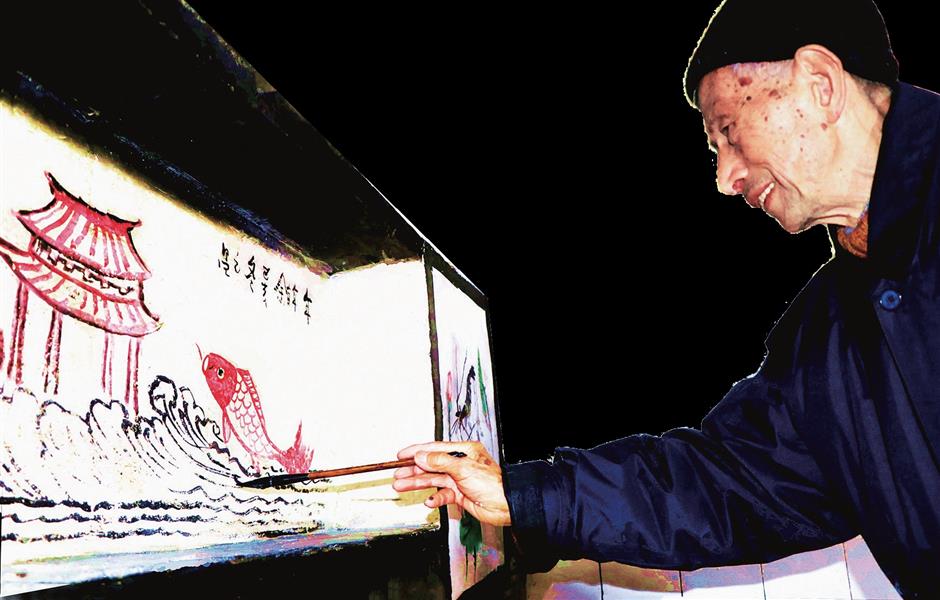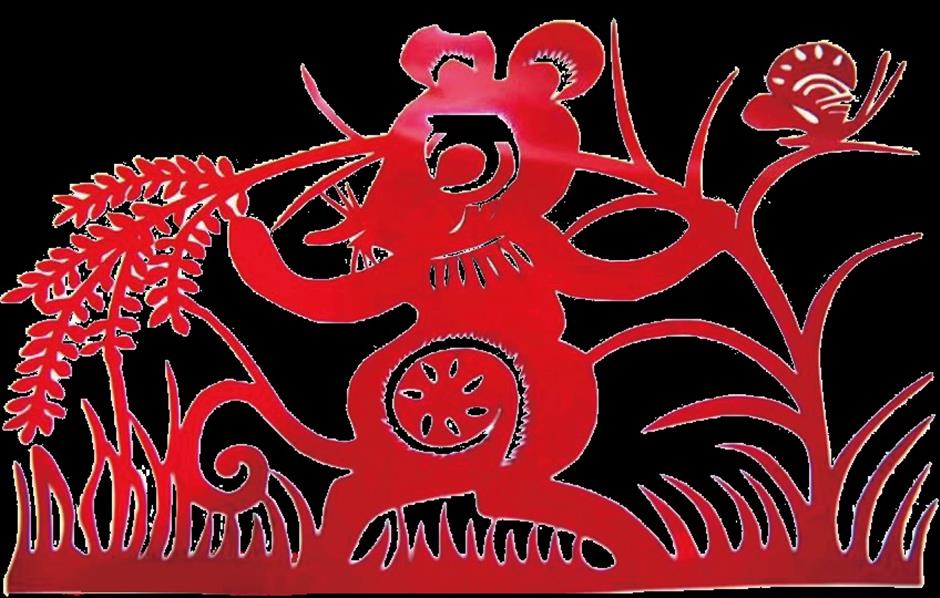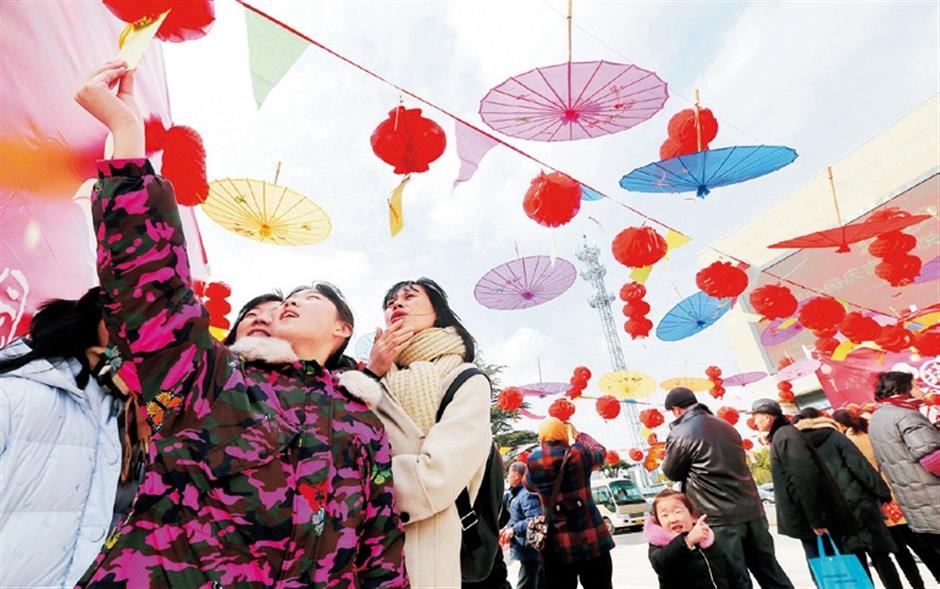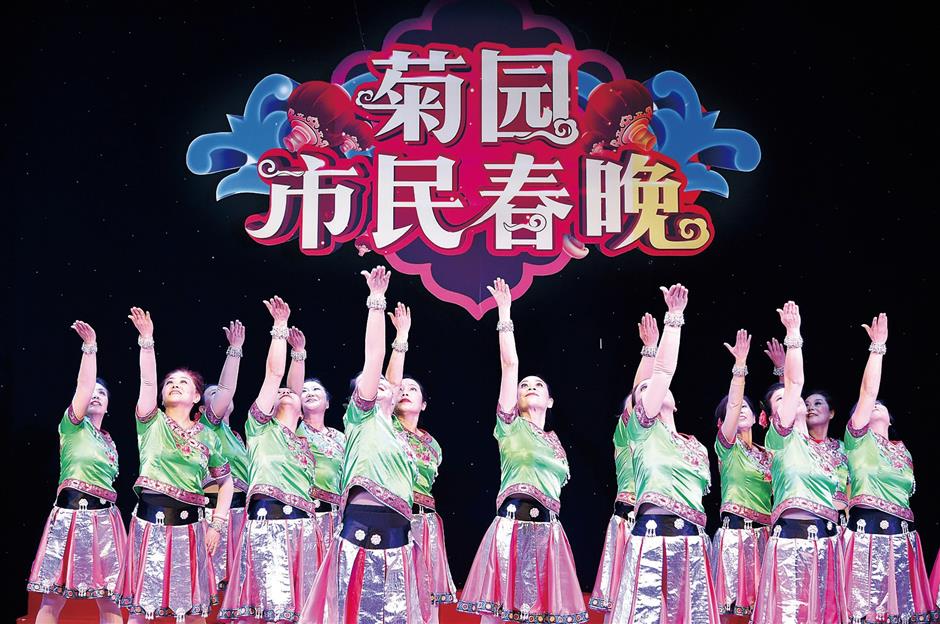Celebrating with cake, paint and dragon dancing!
Drawing hearth paintings, making steamed cake, paper-cutting... Every town or community in Jiading has its own customs during the Spring Festival holiday. Follow Shanghai Daily reporter Li Xinran to see the special events in Jiading.
Anting Town

Wang Yuanchang, an 87-year-old hearth painter in Anting, paints a carp leaping over the dragon’s gate, a picture that symbolizes happiness and good luck for the following year.
In Anting Town, people draw hearth paintings or eat steamed cakes as part of the Spring Festival celebrations.
Every farmhouse used to have a hearth for cooking, and every one painted with auspicious patterns and characters. It was once an essential custom for every family to repaint the hearth before the Spring Festival.
Hearth paintings were popular in Jiangnan, regions south of the lower reaches of the Yangtze River. Simply outlined in bright colors, they are very decorative.
Painters depict various auspicious patterns through the festive colors, such as bright red, goose yellow and green. For example, the meaning of rooster is to urge people to get up early, to be hardworking and to be rich.
Carp are drawn as the Chinese word for fish is a homophone for the word surplus, lending thoughts and hopes for surplus for the new year.
There is a Chinese proverb that goes “carp leaps over the dragon’s gate” suggesting “a person working hard and diligently will one day achieve the success.”
With the urbanization of rural areas and the renovation of old houses, gas stoves replace hearths, and the hearth painting rooted in rural areas, as an important part of folk art, is gradually fading away, so protection and inheritance of the art is important.
Wang Yuanchang, an 87-year-old hearth painter in Anting, drew for a family in Qian’s Village recently.
Before drawing, he first used lime water to paint the hearth. After it dried, he drew a frame along the edge of the hearth in black ink, and then began to paint.
The picture of a carp leaping over the dragon’s gate is lifelike.
A smaller hand-painted lotus to the next implies family harmony as “lotus” and “harmony” sound the same in Chinese.
The paintings by Wang attracted neighbors. “What a good painting!” said one of them, “This shrimp looks like a real one.
“I’m so glad to see hearth paintings again, after decades, as they were previously part of my childhood memory.”

Elderly residents at one of the district’s nursing homes enjoy steamed cake, a must for people during the Spring Festival holiday.
Eating steamed cake is a must for people in Anting during the Spring Festival holiday. “Cake” and “going upward” sound the same in Chinese.
However, there are fewer and fewer people making steamed cakes. Xu Qinglong is one of a small number who adhere to this traditional skill. Xu and his wife have been making steamed cakes in the traditional way for 20 years.
Wood in the hearth is blazing. A steam stove in the kitchen is connected with the hearth through pipes. Xu’s wife Shi Qinzhen puts sifted rice flour into a mould, compacts it gently, and steams it.
Every half minute or so, another layer of rice flour will be flattened in the steamer, three layers in a row. More than two minutes later, a steamed cake with fragrance is the result. Take a bite while still hot and you can feel it’s soft and waxy but not sticky, sweet but not greasy.
The making of steamed cake seems simple, but from weighing the rice, soaking, drying, powdering, sugar mixing, screening, steaming to packaging, there are eight steps.
The rice needs to be mixed with a certain proportion of glutinous rice, soaked for half an hour, dried, and then sent to the rice mill to be rolled into flour before being mixed with sugar and steamed. Controlling the heat is very important in the steaming process.
“We make our own bean paste, sugar and rice flour, without saccharin or food additives.
What we eat is the original taste, which is also reassuring,” said Xu, 56, who learned to cook from his grandfather.
Nanxiang Town

An image of rat cut out by Lu Linyuan, a paper-cutting master, to mark the Year of the Rat.
Paper-cutting is an important Spring Festival tradition in Nanxiang.
Lu Linyuan is a paper-cutting master in Nanxiang. A retired teacher, he cuts new and unique patterns, different from the traditional ones. He is often invited to give paper-cutting courses to local residents.
During the Spring Festival, each neighborhood holds paper-cutting exhibitions.
Among the paper-cutting patterns, there are familiar old streets, zodiac animals, Wenzaobang Bridge, and beautiful Nanxiang girls.

Residents in Nanxiang Town love to solve lantern riddles at the Confucius Temple every Spring Festival holiday.
People in Nanxiang also love to solve lantern riddles. For a long time, Nanxiang Town has had a strong tie with lantern riddles for a long time. Solving lantern riddle activities are held every Spring Festival holiday.
Malu Town

Residents in the Juyuan New Area dance at the Spring Festival Gala.
“Our Spring Festival Gala” is held every year in Malu. All the performers are local residents. Last year, the gala was staged at the Shanghai Poly Grand Theater. This year’s was held at the Stage Show Theater of Jiading Culture Pavilion.
Malu people usually make salted meat, fish, duck, chicken and other salted foods in the last month of the lunar calendar.
Li Pinyou from Li’s Village is good at salting food, such as bacon, salted fish and pickled melon. “I make salted food every year, and have summed up my experience. With pepper, the bacon is more fragrant,” he said.
Jiangqiao Town
Jiangqiao mutton has been made by the Zhu’s family for generations.
The sheep are raised on grass and ready for the pot at one year for a ram and two years for a ewe. They should be about 30 to 40 kilograms in weight. The sheep are killed in the afternoon in summer and in the morning in winter. Control of the heat is very important in cooking. Last but not the least is to add seasoning. When and what to add are kept secret.
Decorations made for Jiangnan sizhu, string and wind musical instruments, are famous. The performance of Jiangnan sizhu is always held during celebrations, including the Spring Festival.
Decorations made in Jiangqiao for the musical instruments of the performance usually adopt beads, sequins, silk cloth and tassels.
They are inlaid in strings, and the decorations are hung on the musical instruments.
Xuhang Town
People in Xuhang sing songs in the 12th month in lunar calendar, perform dragon dances in the first month, and fly kites in the second month.
Like lion dances, dragon dances are most often seen in festive celebrations. Dragon dancing in the Spring Festival is a long-standing traditional way of greeting the new year, a sign of prosperity and good weather in the coming year.
During the Spring Festival, there’s dragon and lion dancings everywhere in the town.
















